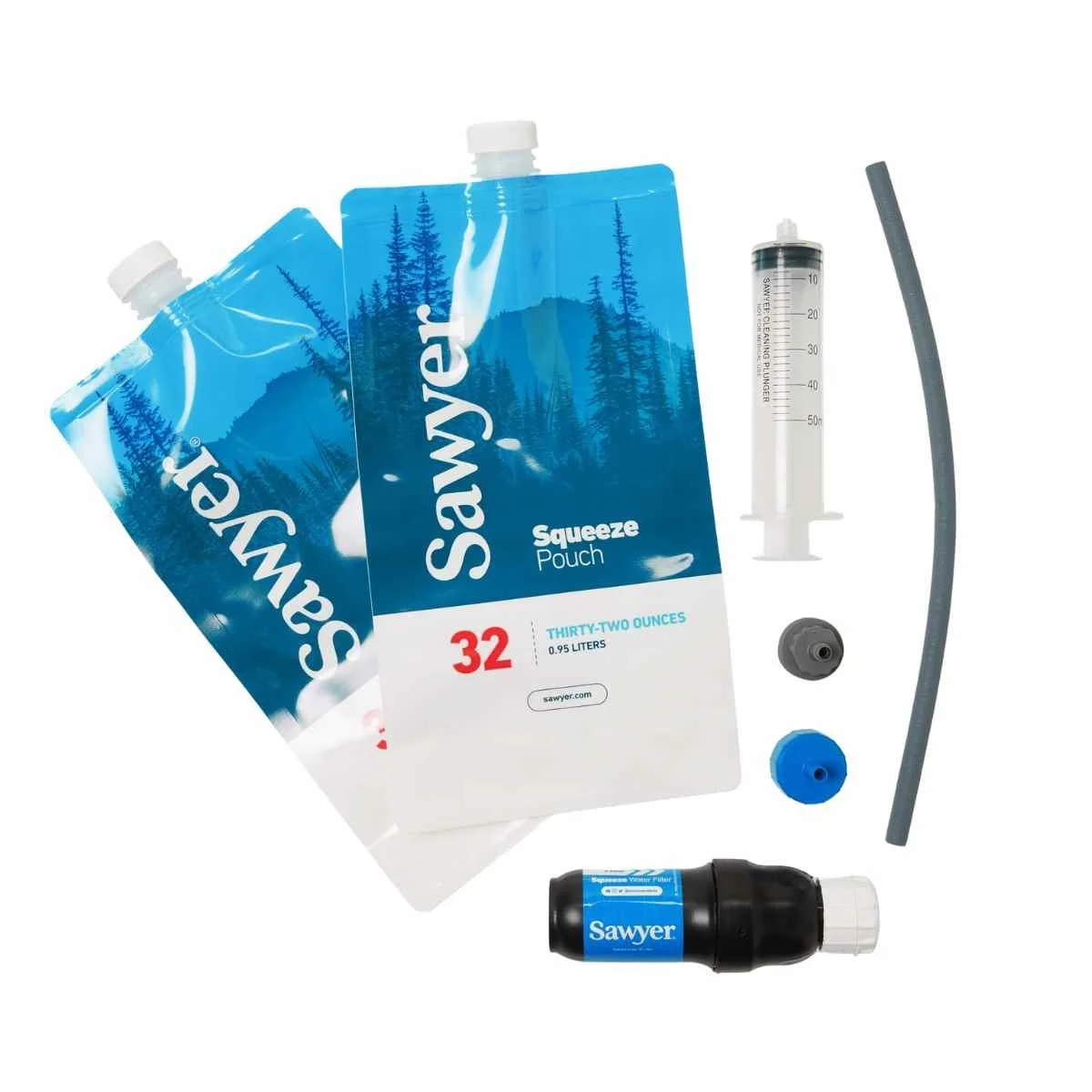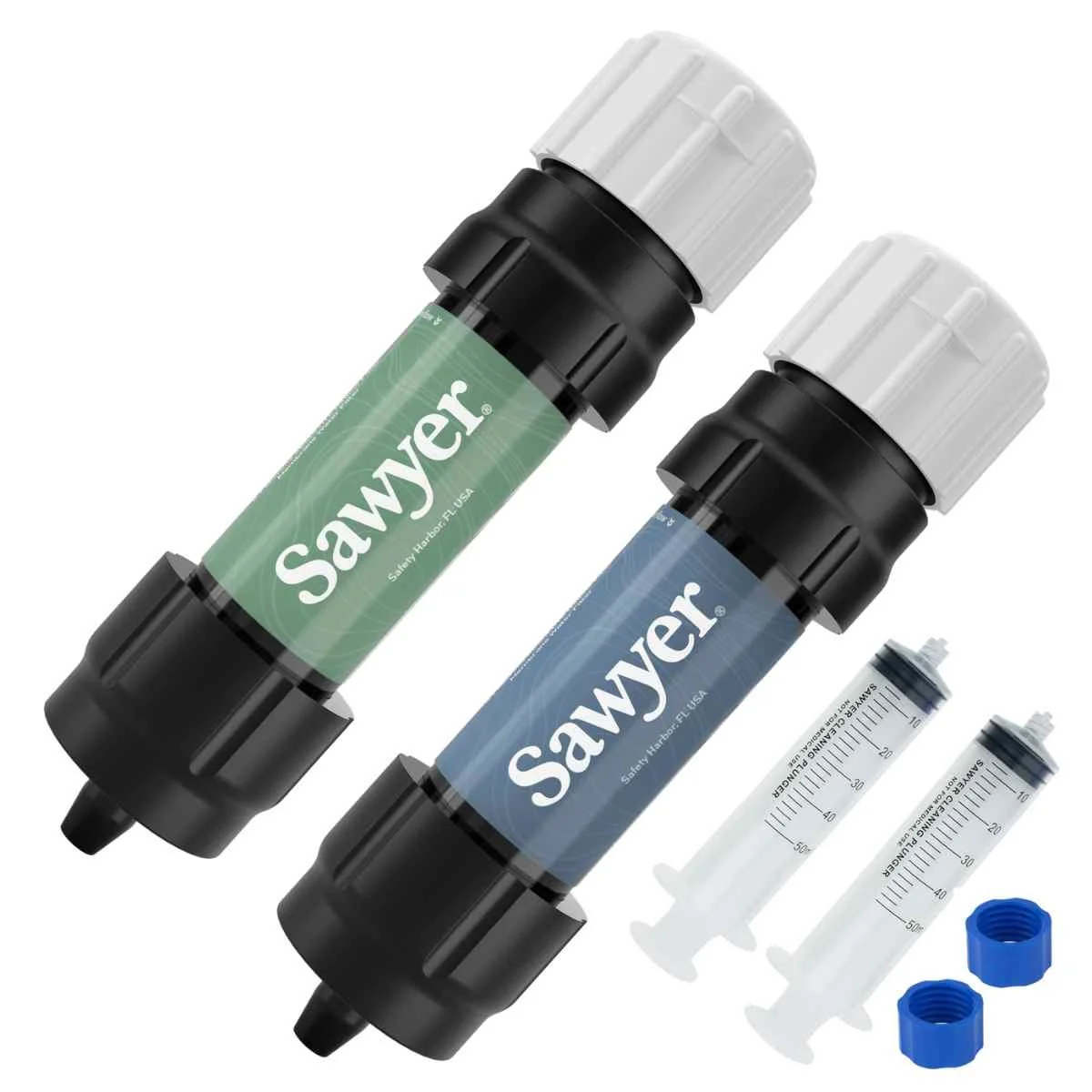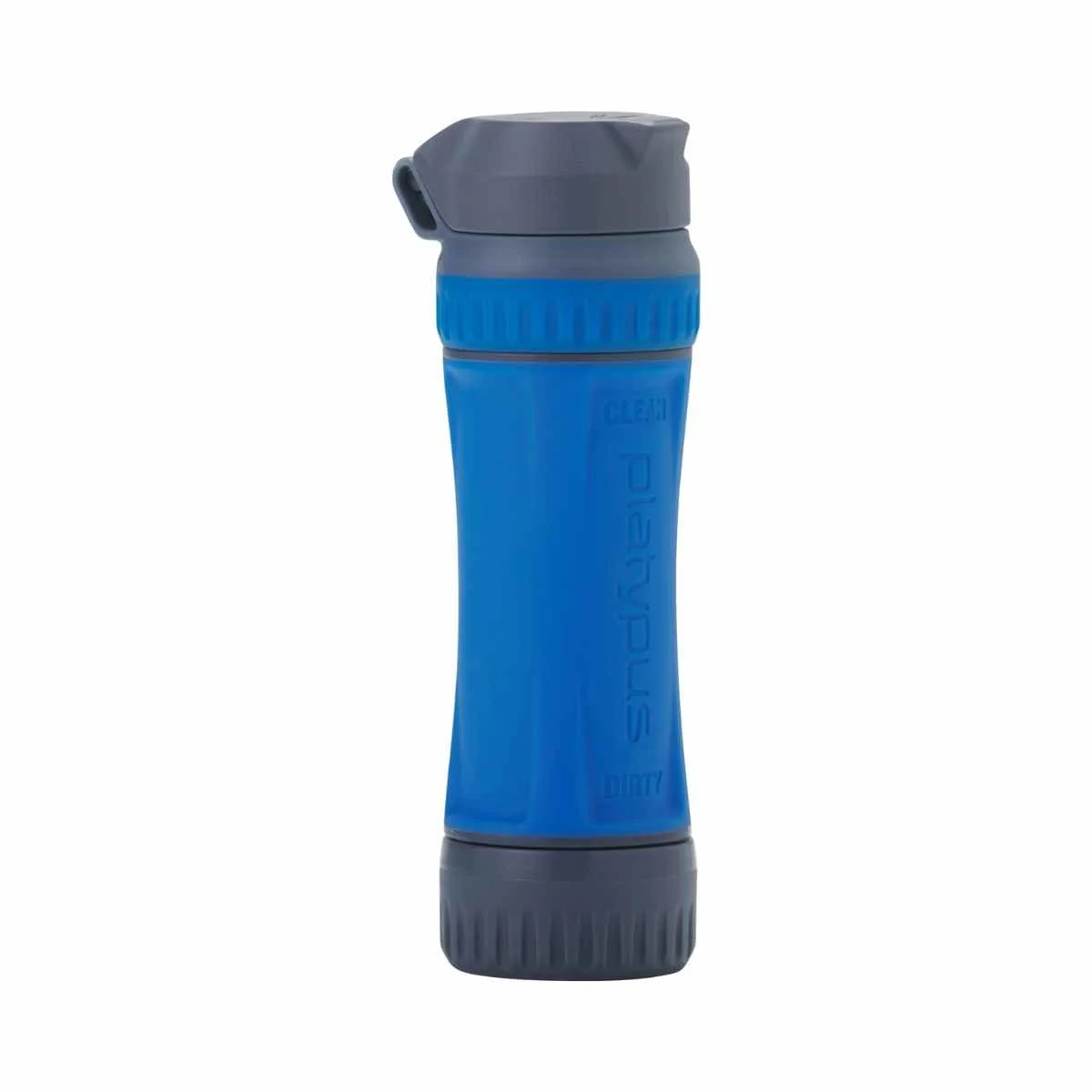Sawyer Squeeze Water Filter Review
An in-depth review of our favorite, trustworthy water filter for thru-hiking
August 27th, 2025
Home > Gear Reviews > Backpacking
Our verdict
The Sawyer Squeeze is a tried-and-true filter that has an excellent speed-to-weight ratio. As the winner of our Best Thru-hiking Water Filter in our Best Backpacking Water Filters and Purifiers guide, we have a lot of wonderful things to say about it.
The number of high-quality and high-star user reviews at Amazon, REI, and Backcountry speak to how well the Sawyer Squeeze is regarded. It also made the best-of lists on four out of the seven sites we aggregated from.
The weight of the Sawyer Squeeze (3 ounces for the filter — 5.8 ounces with the two provided bags) and the speed of its filtration can’t be beat. While you can filter dirty water from the bags the Squeeze comes with, we prefer to drink straight through the sports top, getting our fix instantly.
We tested the Sawyer Squeeze over hundreds of miles on numerous thru-hikes—from the PCT to the Arizona trail—filtering everything from barely trickling streams, to cow trodden water. Our biggest complaint with the Sawyer Squeeze is the bags that come with the product (they’re not the easiest for gathering water from the source) and that the filter can leak in your pack if you’re not careful. However, we’ve found many ways to use the Squeeze with other products that eliminate these issues, and overall believe it to be one of the best filters out there, especially for thru-hikers needing to ensure they’re filtering out any possible protozoa and bacteria from questionable water sources.
The Squeeze’s lifetime warranty and promise of filtering a million gallons over the course of a lifetime makes it the cheapest filter over time that we’ve reviewed, providing clean water at under a penny per liter.
Sawyer Squeeze Water Filter
We create reader-supported, objective, independently-selected gear reviews. This story may contain affiliate links, which help fund our website. When you click on the links to purchase gear, we may get a commission, without costing you an extra cent. Thank you for supporting our work and mission of outdoor coverage for every body! Learn more.
Sawyer Squeeze Specifications
Price: $65
Weight: 3 oz (just the filter); 5.8 oz (filter and bag)
Dimensions: 19 x 6.5 x 2 inches
Filer type: Gravity squeeze
Filter medium: Hollow-fiber membrane
Housing material: Polypropylene/polyethylene
Output: 100,000 gallons
Removes/Destroys: Bacteria, protozoa, and microplastics
BPA free: Yes
Field cleanable: Yes
Best for
Thru-hikes with unideal water sources (when you really want to have reliable filtration)
Backpackers and thru-hikers
Any water source (from your kitchen sink to muddy, pastoral fields)
Comparison table
| WATER FILTER | MSRP | WEIGHT (OZ)* | TYPE | SPEED | FILTER SIZE (μm = MICRONS) | REMOVES PROTOZOA & BACTERIA | REMOVES VIRUSES | REMOVES HEAVY METALS | REMOVES MICRO PLASTICS? | LIFETIME (L) | PRICE / L |
|---|---|---|---|---|---|---|---|---|---|---|---|
| Sawyer Squeeze Filtration System with CNOC Bladder | $65 | 3.0 | Squeeze / gravity filter | 1.7 L/min | 0.1 μm absolute | 3+ mil | <$0.01/L | ||||
| Sawyer Squeeze Water Filter System | $46 | 3.0 | Squeeze / gravity filter | 1.7 L/min | 0.1 μm absolute | 3+ mil | <$0.01/L | ||||
| Platypus QuickDraw Filter | $40 | 2.9 | Squeeze filter | 3 L/min | 0.2 μm | 1,000 | $0.04 | ||||
| Katadyn BeFree AC | $45 | 2.3 | Squeeze filter | 2 L/min | 0.1 μm | 1,000 | $0.05 | ||||
| MSR TrailShot | $65 | 5.2 | Hand squeeze filter | 1 L/min | 0.2 μm | 2,000 | $0.03 |
What we liked
Excellent filtration flow
Ability to use in a gravity system or as a “straw”
Filters out the hard stuff
Very affordable for how long it lasts
What could be better
Leak prevention
Bladder that comes with filter is hard to gather water with due to narrow opening
How we tested
Our testers have used the Sawyer Squeeze on the Pacific Crest Trail, the Arizona Trail, the Oregon Desert Trail, and the Colorado Trail (almost 5,000 miles!) and some of them are still using the original filter they purchased for their thru-hikes years later. We’ve used the Squeeze to filter water from ideal water sources (like alpine streams) and less than ideal sources (like tanks and livestock range waters) and we’ve never experienced failure to provide clean drinking water.
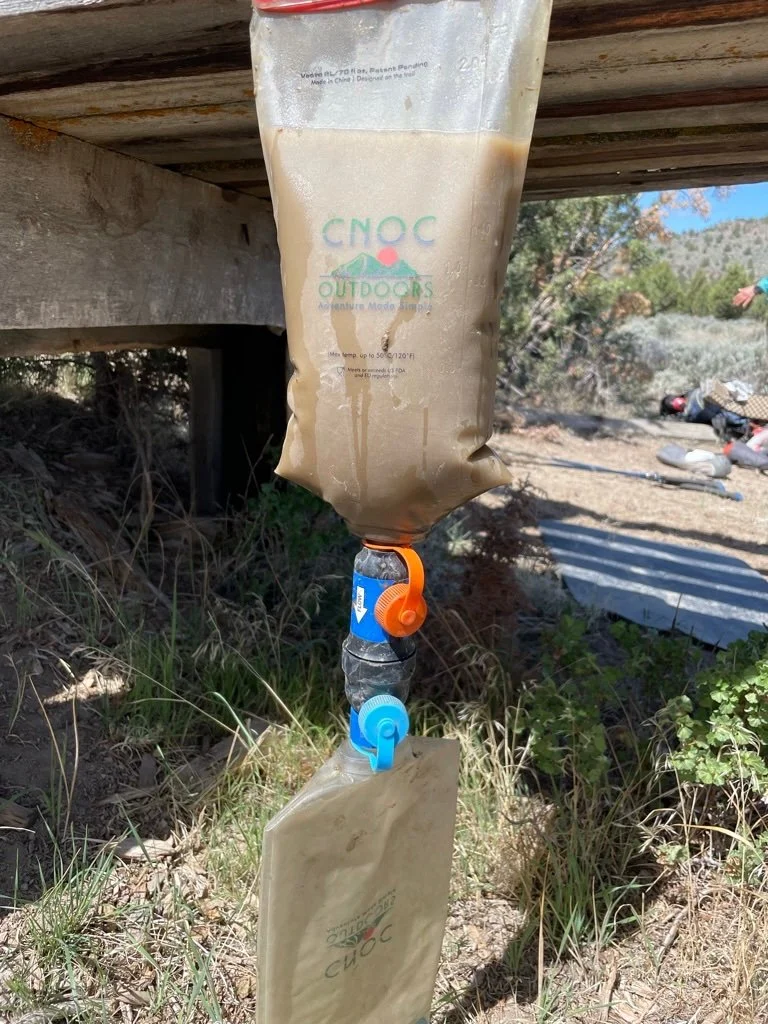
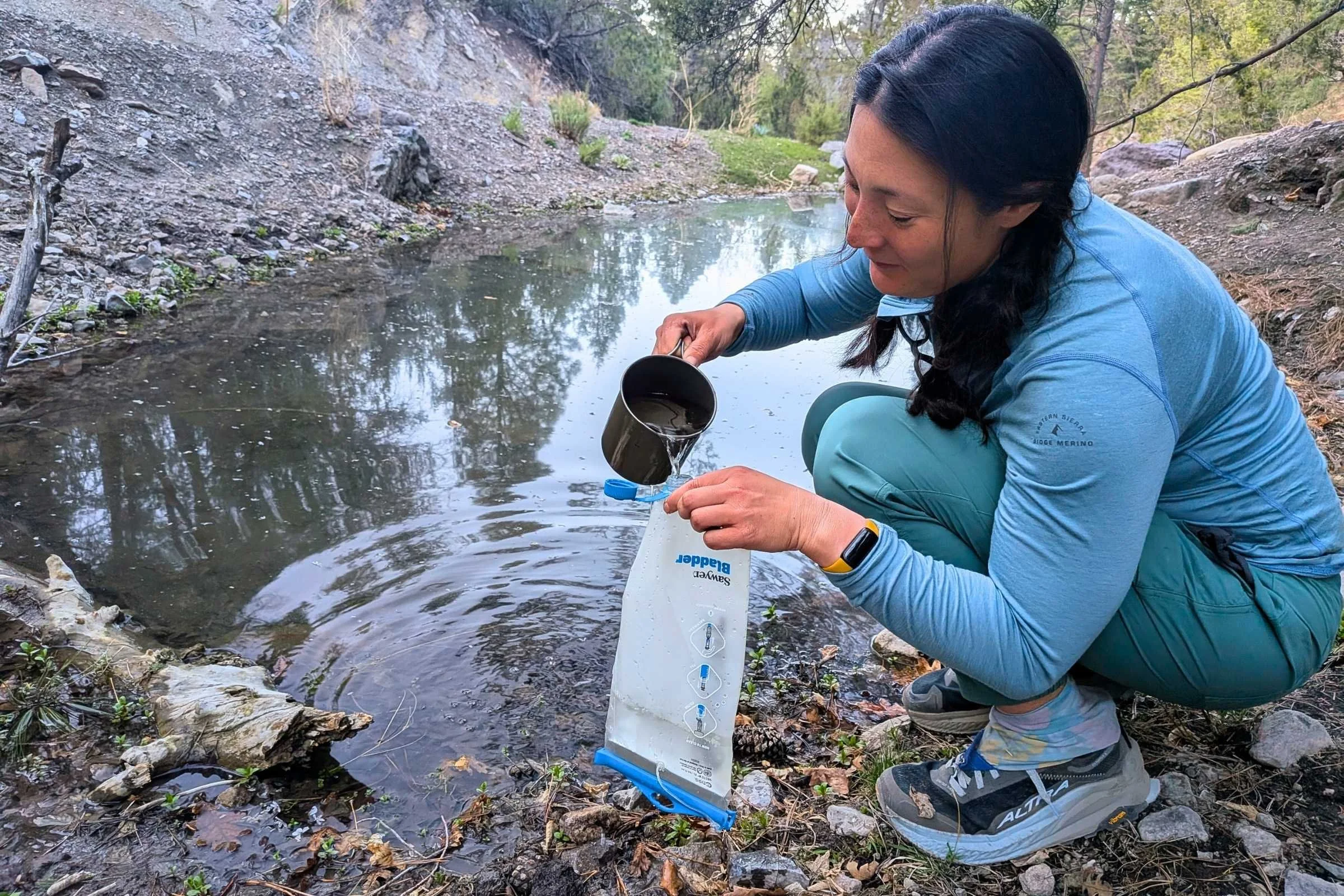

Performance in the Field
Treeline Review co-founder Naomi Hudetz backflushing the Sawyer Squeeze filter.
-
We love the Sawyer Squeeze because of its versatility, providing multiple options that are all very easy for filtering water. If you’re more of an on-the-go water drinker, you can use the Sawyer as an inline filter and drink straight through a hydration hose with minimal alteration to your hose and filter.
Take the sports top off the Sawyer and attach the inline pieces to both sides. Then, cut your hose and attach the cut ends to either side of your filter with the “clean” side facing towards your bite valve. Then, voila: you can add dirty water to your hydration bladder, suck it through the filter, and drink clean water.
Our testers didn’t notice a reduced flow. And at night, that same system can be hung as a gravity filter. Just pop off the bite valve and use the system to collect clean water into a bottle or cooking pot.
Our preferred method is to attach the Squeeze to a SmartWater bottle or CNOC hydration bladder for a gravity filtration system. (Watch your gasket, though—this O-shaped ring makes a seal with the bladder or bottle, and is prone to falling out of the filter if you’re not careful. If this happens, Sawyer will replace it, or you can save on shipping by replacing the ring at a hardware store for fifty cents.) We find the CNOC hydration bladder to be sturdier than Sawyer’s bladder, and better for gathering water from low-flowing or difficult sources.
-
If cleaned and stored properly, we’ve found that the Sawyer Squeeze offers some of the best and quickest flow of any other filter on the market. The generous, steady flow seems to stay the same whether you’re using it as a straw (attaching it straight to a bladder or water bottle and drinking) or as a gravity system.
Our testers have found that they can filter a larger quantity more quickly when pairing the Sawyer Squeeze with Sawyer Coupler and CNOC bladder bags, filtering 2 liters in less than 5 minutes, hands free. (To see this filtration set up, read our PCT Southbound Gearlist and Strategy article.)
-
Even when using the Sawyer Squeeze on sandy, silty water in desert sources on the Arizona Trail, we found the water to look and taste clean. The Sawyer’s hollow-fiber membrane removes nearly 100% of all parasites (like giardia and cryptospordia) in addition to 100% of microplastics. One tester recalled filter water from a muddy livestock range on the Colorado Trail with cows grazing feet away from them, and their water tasted great and did not make them sick.
-
At 3 oz, the Sawyer Squeeze is incredibly lightweight and easy to bring with you on the trails (although, some lightweight thru-hikers prefer the Sawyer Squeeze Mini for being even lighter and more compact). The main thing to consider with packing the Squeeze into your backpack is leakage—it’s hard to shake out all of the water after using the Sawyer Squeeze, and because of this, it can sometimes leak in your pack. This is why we pack ours in an exterior mesh pocket or attached to a Smart Water bottle (straw style).
It is important to remember that the Sawyer filter can freeze. Unfortunately, if this happens, it does mean the filter is no longer usable. For this reason, we sleep with our Sawyer Squeeze in our sleeping bags if we know the temperature is going to be dropping at night. This is also important for storage off trail—make sure your Squeeze is not sitting in a garage during freezing winter temperatures (we’ve had to learn this the hard way).
-
The Sawyer Squeeze is relatively easy to clean on the go, but does require carrying an extra piece of gear (the syringe that comes with it) or purchasing the Sawyer Coupler. The syringe is super lightweight, and really effective at backwashing the filter, helping keep the flow steady.
All you have to do is fill the syringe with clean water (so plan ahead and have clean water in your water bottle!) and alternate pushing it through the input and output spouts of the Sawyer Squeeze until water flows clear. Alternatively, if you have the coupler, you can attach your Sawyer filter directly to your clean water bottle (with a compatible screw top, like a SmartWater bottle) and backflush that way. We found cleaning our Sawyer Squeeze every 100 miles or so, or whenever you’re taking a day off in town, keeps the Sawyer unclogged and filtering consistently.



Features
-
The Sawyer Squeeze’s absolute 0.1-micron hollow fibers remove protozoa, bacteria, and cysts from the water it filters. This means you’re covered for things like cryptosporidium and giardia, which are the most common worries for U.S. and Canadian travel. If you’re traveling in a place where sewage is more of a concern, you’ll want a purifier like the MSR Guardian or the SteriPen Ultra, to make sure you get viruses out of the water as well.
-
Due to its versatility and compatibility with many other water vessels and attachments, the Sawyer Squeeze can be used as a “straw” (drinking straight from a dirty bag or waterbottle, or an inline tube/mouth piece) a gravity squeeze (attaching it to a dirty bladder and filtering into by squeezing the bladder a a clean water bottle), or a gravity filter (using the the Sawyer Squeeze to connect a dirty bladder to a clean bladder, hanging it, and letting gravity do the work). The Sawyer’s adaptability is what makes it a favorite among thru-hikers.
-
The inline adapters that come with the Sawyer Squeeze screw onto either end of the filter and allow you to attach a hose, connecting the filter to the bladder. This can be used for an inline hose system in your pack (sucking water through a mouth-piece and hose that filters the water) or for a gravity squeeze system.
The Sawyer Coupler was designed for connecting the filter to a water bottle for backwashing, but also works for connecting two bladders together for a gravity filtration system. (To see how our testers have done it on the PCT, read our Southbound PCT Gear List and Strategy article.)
The Sawyer CNOC Bladder that comes with the filter can screw directly on, allowing for instant filtration. Because of its slim opening, it is hard to gather water from the Sawyer bladder, which is why our testers prefer the CNOC Vecto Water Bladders.
Similar products
Here are other water filters that have stood out during our testing that we think are great alternatives to the Sawyer Squeeze. To learn more about all the filters we tested and how they performed, read our Best Water Filters and Purifiers of 2025 guide.
Sawyer Mini
Weight: 2.3 ounces
Weight: 2.0 ounces
Type: 0.1-micron filter
Liters per Minute: 0.625 L/minutes
MSRP: $25
Removes microplastics? Yes
Best for: emergencies
What we liked: Price, ease of use
What we didn’t like: Flow rate
We’ve used both the Sawyer Mini and Sawyer Squeeze over thousands of miles and diverse terrain, from desert to alpine (the Mini is just like the Squeeze, but smaller and slower). The Mini is our choice for Best Affordable in our Best Backpacking Water Filters and Purifiers guide.
Overall, we’ve found that the weight penalty with the Squeeze is worth the better flow rate. Especially for longer trips, the slower flow rate was frustrating.
However, if you’re not concerned with flow rate and want to save both money and weight, the Sawyer Mini can’t be beat.
Sawyer Mini
Weight: 2.9 oz
Type: Hollow fiber, squeeze
Liters per minute: 3
MSRP: $40
Removes microplastics? Not stated
Best for: Hikes and shorter backpacking trips, mountain runoff and streams, one person
What we liked: Speed of flow, takes a long time to clog, ease of backflushing, dual caps prevent leaking and are attached so can’t lose them, integrity test indicator tells whether it is still functioning after a freezing night
What we didn't like: Cartridge only lasts 1000 L (250 gallons), doesn’t protect from viruses, squeezing can be tedious, requires cleaning with bleach before storing
The Platypus QuickDraw is an ultralight squeeze filtration system that is easy to use, portable, and durable. The filter lasts about 1,000 liters, which works out to $0.04 per liter. Due to some design features, it just edged out the Sawyer Squeeze as our Best Overall Water Filter.
Our testers have taken the QuickDraw on the thru-hikes of the Tahoe Rim Trail and the Grand Enchantment Trail and noted its impressive durability, ease of use and backflushing, and thoughtful design features.
Platypus Quickdraw
Weight: 2.3 ounces
Type: 0.1-micron filter
Liters per Minute: 2.0
MSRP: $45
Removes microplastics? Not stated
Best for: Hikes and trail runs, mountain runoff and streams, one person
What we liked: lightweight, quick filter
What we didn’t like: requires hacks for longer trips
The Katadyn BeFree is a filter that’s essentially the lid on a collapsible water bottle. It’s one of the lightest filters we’ve tested at 2.3 ounces and filters a liter just about as fast as you can drink it. At 0.1 microns, it filters out everything but viruses, and at a lifetime of 1,000 liters, the price per liter is about $0.05.
While we reviewed the 1-liter version and named it Best Water Filter for Short Trips, 0.6 and 3-liter versions also exist if you need more or less drinking water for your excursions. The BeFree might be a better option for hikers and backpackers who are doing fewer miles, since it’s much smaller than the Sawyer.
Katadyn BeFree 1 L
Who should buy this
Buy if you plan on doing a thru-hike or a lot of backpacking trips and want a long-lasting, reliable, lightweight water filter
Skip if you only need water filtration for short distances, and want something lower profile.
Where to buy
The Sawyer Squeeze is a popular filter, so you have options when it comes to retailers. Here are some of the pros of the retailers.
REI
Pros: 100% satisfaction policy for 1 year; 10% dividend for members.
Amazon
Pros: Free 2-day shipping with Amazon Prime membership
Why you should trust us / About the Author
Amanda Jameson has hiked over 3500 miles, including thru-hikes of the Pacific Crest Trail and Colorado Trail and a LASH (long-*ahem* section hike) of the Grand Enchantment Trail. Between those hikes and a stint as a Traveling Trainer for the Leave No Trace Center for Outdoor Ethics, she has slept outside for nearly a year of my life.
Amanda is also an American Hiking Society Next Generation Trail Leader and a Vice-President of the board at the American Long Distance Hiking Association-West, which awards the Triple Crown of Hiking. Her popular blog, Brown Girl on the National Scenic Trail, is a space for intersectional writing to encourage folks of all colors and all walks of life to experience our wild spaces and preserve them for the future. You can see all her Treeline Review articles on her author page.
Naomi Hudetz is director of analytics and digital innovation and leads business strategy and revenue operations for Treeline Review. She brings decades of private sector experience in project management, budget and pricing projection, and long-term business vision, strategy, and goals.
Naomi left her corporate career to pursue her passion for the outdoors. She received the Triple Crown award for hiking for completing the Appalachian Trail, Pacific Crest, and Continental Divide Trail and has hiked numerous other distance routes including the Great Divide Trail across the Canadian Rockies (twice), Grand Enchantment Trail, Pacific Northwest Trail, the Arizona Trail (most of) the Idaho Centennial Trail, the first known thru-hike of the Blue Mountains Trail, and the Oregon Desert Trail. She served as an executive board member of the American Long Distance Hiking Association-West and is based in White Salmon, Washington. You can read all her articles on her Treeline Review author page.
Liz Thomas is an award-winning writer and the Editor-in-Chief of Treeline Review. A former Fastest Known Time (FKT) record holder on the Appalachian Trail. She was guest editor at Backpacker Magazine, where she is currently the columnist of “Ask a Thru-hiker” and instructor of their online class, Thru-Hiking 101. Her first book, Long Trails: Mastering the Art of the Thru-hike, was the recipient of the National Outdoor Book Award for Best Instructional Book called by judges destined to become the “Bible of the Sport.” Liz has talked gear on Good Morning America (TV), in The Wall Street Journal, The Guardian, Buzzfeed, The Washington Post, Men’s Journal, Women’s Health, Gizmodo, and Outside Magazine. She represented the sport of hiking at President Obama’s Great American Outdoors Initiative. You can read all of Liz’s articles on her website or Treeline Review author page.


